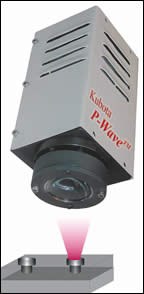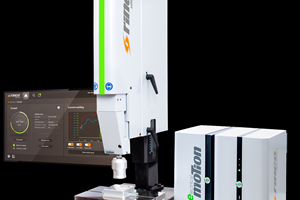New Approach to IR Welding Bonds More Engineering Plastics
Kubota Research Associates (KRA), a U.S.-based research and development firm, has introduced an advanced method for through-transmission infrared (TTIR) welding of sensitive plastic parts.
Kubota Research Associates (KRA), a U.S.-based research and development firm, has introduced an advanced method for through-transmission infrared (TTIR) welding of sensitive plastic parts. This start-up company’s P-Wave TTIR equipment generates polychromatic (multi-wavelength) IR energy, in contrast to the monochromatic (single-wavelength) IR energy used in laser welding.
“P-Wave opens new options in joining clear, opaque, and colored parts and films, and it welds an unprecedented range of engineering thermoplastics,” declares Masanori (Mike) Kubota, president of KRA. As with laser welding, P-Wave focuses IR energy at the zone between IR-transparent and IR-absorptive parts, prompting melting at the interface. That melting, plus application of pressure, creates a bond. However, Kubota argues that P-Wave is a more precise, forgiving, and cost-effective way to weld than with IR lasers.
KRA claims its technology outperforms IR laser, ultrasonic, and conventional IR welding (surface-heating) methods in the bonding of electronic, automotive, and medical assemblies; films used in fuel cells and bio-fluid bags; printed circuit boards; and some composite parts. Surface defects (burns) are said to be minimized. KRA’s technology, when used with associated wavelength transducers, is said to direct IR energy so precisely that higher-temperature resins like fluoropolymers and PEEK become amenable for the first time to TTIR welding.
How P-Wave works
P-Wave equipment is offered in 300- and 150-watt versions, says John Long, KRA’s chief technology officer. Systems include an IR lamp (halogen, xenon, or metal halide) as well as patented optical focusing devices and KRA’s proprietary wavelength transducers. The equipment creates a well-defined welding spot of around 5-mm diam., and robotic raster scanners can be used to extend the weld area.
KRA’s lamp and optical devices create a filtered-bandwidth, cone-like beam that “paints” IR energy accurately and deeply on the interface zone, making localized precision welding feasible. The patented optics condense the IR beam to the extent that it penetrates more deeply into the plastic part than laser energy, while minimizing surface damage.
In the vast majority of cases, P-Wave welding is most effective with the use of a wavelength transducer, Long says. The transducer is a plastic film, ribbon, or die-cut device made of IR-absorptive materials and positioned above or below the parts being joined (Fig. 1).
Like a lens, the transducer focuses the IR beam’s energy at the weld interface, increasing flux density by 300% and speeding the rate of melting in the weld area. Transducers can be designed to conform to the joint, which facilitates welding of complex 2D and 3D bonds. Units can weld films, membranes, cloth, sheet, pipe, tube, and moldings.
Wavelength transducers allow joining films of natural (IR-transparent) materials into bags and containers, an example being polyolefin blood and bio-fluid bags. These flexible containers could replace existing PVC versions, removing the risk of toxic emissions generated during incineration of the vinyl bags. P-Wave units are also able to weld nonwoven bags and medical wraps made out of DuPont’s Tyvek films. Another application is fluoropolymer bags used in biological and environmental sampling procedures.
KRA wavelength transducers boost IR absorption sufficiently to weld a broader range of materials than is possible by other methods. Besides PS, PE, PP, and other polyolefins, the “weldables list” includes most fluoropolymers and polyketones (PEEK) PEI (GE’s Ultem), polyimide, UHMW-PE, PC, nylon, acetal, PVC, TPO, and other TPEs.
Kubota says several applications currently using adhesive bonding appear likely to benefit from this capability. He cites printed circuit boards bonded with polyimide film, fuel cells bonded with fluoropolymer film, and graphite or carbon composites with PEEK or PEI binders. Furthermore, in contrast to existing methods, KRA’s transducers are reusable, are not consumed in the process, and are not incorporated into the assemblies. IR laser welding uses far more costly approaches in which one of the parts being joined incorporates an IR-absorptive additive or coating.
KRA reports that one of its 300w systems is already being used by a U.S. medical device maker, which it declined to identify. The unit is used for 2D and 3D welding of PP, PE, ABS, and PC medical devices, one rationale being the absence of residuals after welding. KRA claims P-Wave equipment is also less costly than IR laser or ultrasonic systems. Basic P-Wave hardware costs around $20,000, or a half to a third less than for an IR laser.
Maintenance costs are also said to be low. Heads weigh less than 4 lb and integrate well into automated production lines. KRA systems also require no shielding devices to protect operators. IR-transparent parts containing a wide range of colors can be successfully welded.
Solving the‘Three Rs’
P-Wave systems can also be used to weld and “reverse-weld” assemblies by means of proprietary detachable fasteners. These fasteners are supplied in rivet, plate, strip, and clip designs. They are suited to assemblies that are to be refilled (like printer ink cartridges), repaired (e.g., appliance parts), or recycled (automotive parts).
Rivet fasteners are designed with an IR-transparent upper and IR-absorbing lower section to allow the welder to rivet parts together and also make it possible to detach and separate them later (Fig. 2). Alternatively, the fasteners can be IR-transparent for welding onto IR-absorptive substrates.
KRA portrays its fasteners as alternatives to adhesives, mechanical fasteners (screws and bolts), and heat-staking methods. Their high bond strength typically results in 50% fewer connection points than with adhesives or mechanical fastening, Kubota says. When it comes time for disassembly, the fasteners can be detached at high speed.
One developmental application is a two-part vehicle door panel, in which the detachable fasteners reportedly increase door rigidity, slash weight and part count, and make the door considerably more repairable. KRA is also investigating use of its fastening system to weld and seal the detachable lids of refillable toner cartridges for a printer. The lid is strong, leak-proof, and tamper-evident; yet it can be removed in a non-destructive way when the toner is exhausted.
Related Content
Polyfuze Graphics Corp. Partners With RFID Specialists
To help customers navigate the complexities of RFID technology, Polyfuze has partnered with such companies as HID Global.
Read MoreNext-Generation Fully Electric Ultrasonic Welding System
NPE 2024: Rinco new eMotion servo-driven machine is available in 20 kHZ and 35 kHz frequencies.
Read MoreAll-Motor Driven Pad Printing Machine
Deco Technology now selling the new ML-500E linear & servo motor driven from microPrint of Switzerland
Read MoreLED Signal Tower Available in White, Cleanroom Ready
Werma’s eSIGN LED signal tower is now available in white, with a variety of signaling modes.
Read MoreRead Next
Lead the Conversation, Change the Conversation
Coverage of single-use plastics can be both misleading and demoralizing. Here are 10 tips for changing the perception of the plastics industry at your company and in your community.
Read MoreBeyond Prototypes: 8 Ways the Plastics Industry Is Using 3D Printing
Plastics processors are finding applications for 3D printing around the plant and across the supply chain. Here are 8 examples to look for at NPE2024.
Read More














